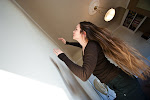I want to write a bit about two of my projects, in which I have focused on aspects of time.
The solo I danced at the Subterranean Arthouse in Berkeley this past weekend is a finale of a 50 min dance piece "Raja", that premiered in Helsinki, Finland in November 2007. In "Raja" tempo is the defining aspect of the piece.
Initially my intuition directed me to try out the movements really slowly. It felt good, but I also wanted to see what it looked like. Sanna From, who was rehearsing "Raja" with me, was my guinea pig. I found slowing down focused viewer attention to the movement. I didn't want the choreography to flow away, I really wanted it to be observed. Immediately the movement qualities became highlighted.
Slow performance demanded a deep concentration that produced stillness, the stillness further enhanced the audience's focus. In this case slowness produced a meditative state that enveloped the dancers and the audience alike (based on audience response).
Slow also has an aspect that is more radical. That's because we don't really like slow. Things should happen fast and snappy, anybody slow is clumsy or dimwitted. Slow performers will fall out of the big competition that is life, fast people simply achieve more. Of course we know that more is not better, so people have the slow food -movement, alternative education, sabbaticals. These are for and by the deviants, the activists, the radicals. How about normal people?
A friend once told me how she had stuffed cotton balls into her nostrils in order to sound like she had the flu - so she could be convincing when she notified the office. She is a high achiever, but she needs a day or two of slow to achieve that high performance. After her confession we were both embarrassed, because no matter how much we like slow times, we definitely do dislike slow times. During high unemployment the difference between one person's busy and another person's slow becomes amplified.
Past summer I composed a new piece called "Things" at the Garage in San Francisco. In "Things" I am connecting the ideals of tempo and achievement to the ideas of a person and a thing. A person would do, produce, perform, leave traces, move. A thing would do none of these things. What if a person would be stripped of doing, producing, performing, leaving traces, moving? How would we look at that person, and how would we value her/him?
Duration and the rhythm of performance became focus of "Things". The person on stage is first in fast movement, stopping suddenly. On several occasions she is on hiatus for lengths of time. An unnatural and at times uncomfortable slow rhythm of performance feels necessary to bring over the point.
I think I wasn't radical enough with the timing, not sedate enough in the performance. I'm looking forward to putting up a next version of "Things" so I can create, and give myself and the audience the chance to investigate, that physical reality.
My chosen channel of creativity is dance, and western theatrical dance is the tradition that I have grown into. If there ever was a world where high achievement and top performance is demanded for simple survival, it is the tradition of western theatrical dance. Although I identify with the margin that is in continuous revolt against values of traditions past, the hardcore where the revolt is wholly followed through is tiny. I hold no pure convictions myself. So I am composing for an ambiguous audience that has conflicting expectations. I know I have to transgress the limits one of my own comfort zones here, concerning the dark side of pace and achievement. And my mean of transgression will be performance timing.
I'm posting a couple of related links I have enjoyed.
Stefan Sagmeister on time off
Linton Kwesi Johnson: More time


